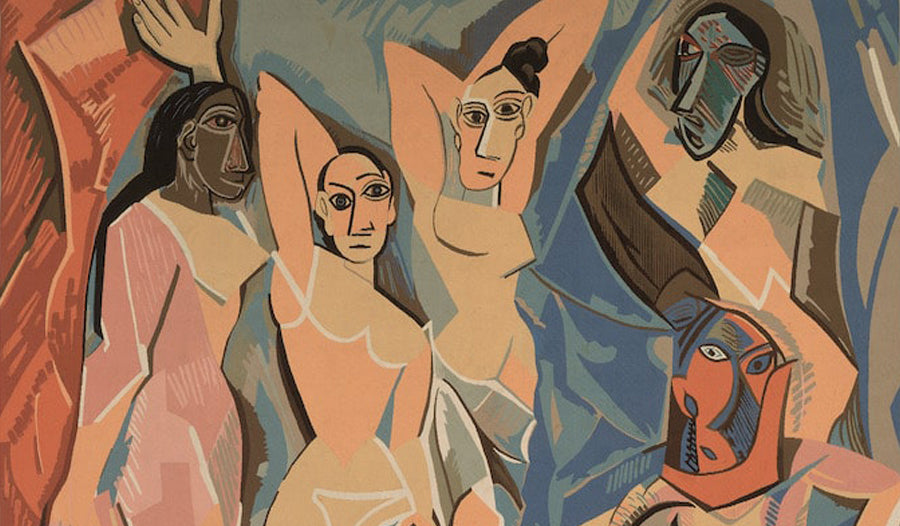
THE OTHER DEMOISELLES D'AVIGNON
 Image: Jacqueline Dürrbach, after Pablo Picasso Les Demoiselles d’Avignon. Cavalaire-sur-Mer 1958, after original 1907 painting. Wool tapestry 272 x 255 cm. Fundación Almine y Bernard Ruiz-Picasso para el Arte, Madrid. On temporary loan to the Museo Picasso Málaga © FABA photo: Hugard & Vanoverschelde Photography © Estate of Jacqueline de la Baume-Dürrbach, all rights reserved.
Image: Jacqueline Dürrbach, after Pablo Picasso Les Demoiselles d’Avignon. Cavalaire-sur-Mer 1958, after original 1907 painting. Wool tapestry 272 x 255 cm. Fundación Almine y Bernard Ruiz-Picasso para el Arte, Madrid. On temporary loan to the Museo Picasso Málaga © FABA photo: Hugard & Vanoverschelde Photography © Estate of Jacqueline de la Baume-Dürrbach, all rights reserved.
Currently on display at Museo Picasso Málaga is a tapestry of the artist’s iconic painting, Demoiselles d’Avignon (1907) woven by Jacqueline Dürrbach. In the early 1950s the weaver produced a tapestry of the small work Pierrot and Harlequin (1920) followed by the large scale Guernica (1937), which was purchased by the American Nelson Rockefeller and displayed, until recently, in the United Nations as a reminder of the horrors of war.

Dürrbach’s tapestry of Demoiselles d’Avignon dates to 1958 and represents a far greater departure from the original paintings than either earlier work produced. Cubism is credited as emerging at the time of the original painting with Picasso described as “say[ing] goodbye to conventional anatomy, transforming the body into an open framework of planes, cones and cylinders.” By the time Dürrbach wove Demoiselles d’Avignon, Picasso is understood to have authorized and even greater departure from the original painting than appears in earlier works. Where blended colours appear in the painting, Dürrbach wove distinct transitions. Hatch marks are also redistributed throughout the composition.

Image: Roberto Otero (1931-2004). Pablo Picasso in 'La Californie', 4-10-1966. © Museo Picasso Málaga © Sucesión Pablo Picasso, VEGAP, Madrid, 2020
Picasso has been credited with describing Dürrbach’s tapestry of Demoiselles d’Avignon as better than the original painting, despite outrage from some who found the differences between painting and tapestry too great. The tapestry currently enjoys a prominent display in Museo Picasso Málaga. But it may be the works attribution that speaks most accurately to the layering of original painting and the creative licence the tapestry captures. In the lower left hand corner appears both Dürrbach’s trademark of the letters A and C and Picasso’s woven “signature”.
 Image: Roberto Otero (1931-2004). Pablo Picasso in ‘La Californie’. La Californie (Cannes), 4-10-1966. © Museo Picasso Málaga © Sucesión Pablo Picasso, VEGAP, Madrid, 2020
Image: Roberto Otero (1931-2004). Pablo Picasso in ‘La Californie’. La Californie (Cannes), 4-10-1966. © Museo Picasso Málaga © Sucesión Pablo Picasso, VEGAP, Madrid, 2020
Written by Jessica Hemmings
--
Find out more about the display at the Museo Picasso Málaga here: www.museopicassomalaga.org/en/pablo-picasso
Further reading on Picasso, tapestry and the 1958 Demoiselles d’Avignon:
Cécile Godefroy, “Picasso et la tapisserie,” colloque Revoir Picasso, 25 mars 2015
Sheila Gibson Stoodley, “Dream Weavers,” Art and Antiques, September 2009
K.L.H. Wells, “Rockefeller’s Guernica and the collection of modern copies,” Journal of the History of Collections, vol. 27, no. 2, July 2015
